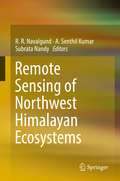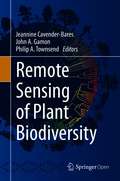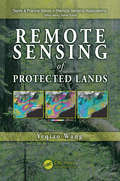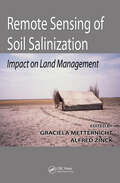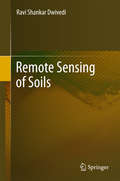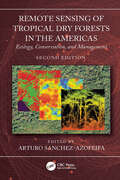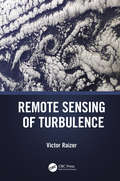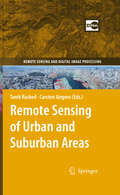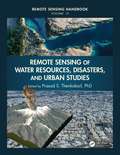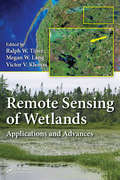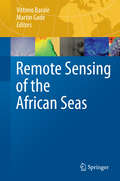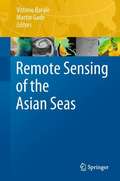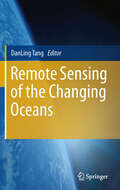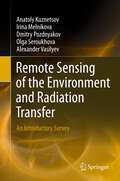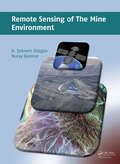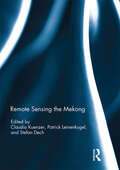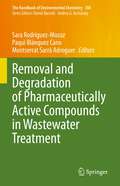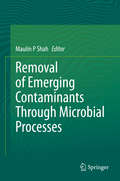- Table View
- List View
Remote Sensing of Northwest Himalayan Ecosystems
by R. R. Navalgund A. Senthil Kumar Subrata NandyHimalaya, one of the global biodiversity hotspots, is the abode of a variety of flora and fauna. The Himalayan ecosystems have immense ecological, socioeconomic, and aesthetic significance as they provide a wide range of ecosystem services. The northwest Himalaya (NWH), covering three states of India viz., Uttarakhand, Himachal Pradesh, and Jammu and Kashmir, starts from the foothills of Shivaliks in the south and extends to the greater Himalaya in the north. This region is also the source of some of the major rivers of India. With the increase in population, the NWH ecosystems have been under threat due to deforestation, loss of biodiversity, expansion of agriculture and settlement, overexploitation of natural resources, habitat loss and fragmentation, poaching, mining, construction of roads and large dams, and unplanned tourism. The Himalaya being young and geotectonically active, remains inherently unstable, fragile, and prone to natural disasters. Climate change is also likely to impact the Himalayan cryosphere drastically. Recognizing the importance of the Himalaya, a National Mission for Sustaining the Himalayan Ecosystem, one of the eight missions under the National Action Plan on Climate Change (NAPCC) of Govt. of India, to conserve biodiversity, forest cover and other ecological values in the Himalayan region has been taken up.Spaceborne remote sensing with its ability to provide synoptic and repetitive coverage has emerged as a powerful tool for assessment and monitoring of the Himalayan resources and phenomena. Indian Institute of Remote Sensing, Dehradun has taken up a number of studies in the fields of geology, water resources, forestry, agriculture, urban settlement, etc., over the last decade. The book summarises the work carried out in different disciplines, illustrated with tables and figures and a host of relevant references. It is hoped that the book serves as an excellent reference of immense value to the students, researchers, professors, scientists, professionals, and decision makers working in the NWH region.
Remote Sensing of Plant Biodiversity
by Jeannine Cavender-Bares John A. Gamon Philip A. TownsendThis Open Access volume aims to methodologically improve our understanding of biodiversity by linking disciplines that incorporate remote sensing, and uniting data and perspectives in the fields of biology, landscape ecology, and geography. The book provides a framework for how biodiversity can be detected and evaluated—focusing particularly on plants—using proximal and remotely sensed hyperspectral data and other tools such as LiDAR. The volume, whose chapters bring together a large cross-section of the biodiversity community engaged in these methods, attempts to establish a common language across disciplines for understanding and implementing remote sensing of biodiversity across scales. The first part of the book offers a potential basis for remote detection of biodiversity. An overview of the nature of biodiversity is described, along with ways for determining traits of plant biodiversity through spectral analyses across spatial scales and linking spectral data to the tree of life. The second part details what can be detected spectrally and remotely. Specific instrumentation and technologies are described, as well as the technical challenges of detection and data synthesis, collection and processing. The third part discusses spatial resolution and integration across scales and ends with a vision for developing a global biodiversity monitoring system. Topics include spectral and functional variation across habitats and biomes, biodiversity variables for global scale assessment, and the prospects and pitfalls in remote sensing of biodiversity at the global scale.
Remote Sensing of Protected Lands (Remote Sensing Applications Series)
by Yeqiao WangNational parks, wildlife refuges and sanctuaries, natural reserves, conservation areas, frontier lands, and marine-protected areas are increasingly recognized as essential providers of ecosystem services and biological resources. As debates about climate change and sustainability intensify, protected areas become more important as indicators of eco
Remote Sensing of Soil Salinization: Impact on Land Management
by Graciela Metternicht J. Alfred ZinckRecognized and advocated as a powerful tool, the role of remote sensing in identifying, mapping, and monitoring soil salinity and salinization will continue to expand. Remote Sensing of Soil Salinization: Impact on Land Management delineates how to combine science and geospatial technologies for smart environmental management. Choose the Right Tech
Remote Sensing of Soils
by Dwivedi Ravi ShankarThis book is about applications of remote sensing techniques in the studies on soils. In pursuance of the objective, the book initially provides an introduction to various elements and concepts of remote sensing, and associated technologies , namely Geographic Information System (GIS), Global Positioning System (GPS) in chapter-1. An overview of the sensors used to collect remote sensing data and important Earth observation missions is provided in chapter-2. The processing of satellite digital data (geometric and radiometric corrections, feature reduction, digital data fusion, image enhancements and analysis) is dealt with in Chapter-3. In the chapter to follow the interpretation of remote sensing data , very important and crucial step in deriving information on natural resources including soils resources, is discussed. An introduction to soils as a natural body with respect to their formation, physical and chemical properties used during inventory of soils, and soil classification is given in Chapter-5. The spectral response patterns of soils including hyperspectral characteristics -fundamental to deriving information on soils from spectral measurements, and the techniques of soil resources mapping are discussed in chapter-6 and -7,respectively. Furthermore, the creation of digital soil resources database and the development of soil information systems, a very important aspect of storage and dissemination of digital soil data to the end users are discussed in ch. apter-8. Lastly, the applications of remote sensing techniques in soil moisture estimation and soil fertility evaluation are covered in chapter-9 and -10, respectively.
Remote Sensing of Tropical Dry Forests in the Americas: Ecology, Conservation, and Management
by Arturo Sanchez-AzofeifaThis second edition focuses on Tropical Dry Forests (TDF) in the Americas and provides a comprehensive overview of new studies conducted in the last decade, giving new insights into the most endangered ecosystem in the tropics. Written by experts in remote sensing, ecosystem services, and ecology, the book concentrates on four thematic areas such as LiDAR remote sensing, remote sensing and ecology, quantification of ecosystem services, and TDF ecology. The case studies presented in this edition provide information on how emerging technologies can be applied to analyze biophysical properties and the status of TDFs across different regions in Mexico, Costa Rica, Brazil, and Bolivia.Features Includes all new content and does not replace the previous edition. Offers insight into the application of airborne and terrestrial laser scanning in tropical dry forests. Discusses ecology, remote sensing, hydrological modelling and ecosystem services. Includes novel information to build additional comparisons with peer-reviewed datasets. Highlights scientific achievements from different countries with tropical dry forests. Enables readers to comprehend and apply further comparative studies within the same ecosystem. This is an excellent book for professionals, academics, and students in the fields of Remote Sensing, Hydrology, and Environmental Science, as well as for Geographers, Ecologists, and individuals involved in the management of tropical dry forests.
Remote Sensing of Turbulence
by Victor RaizerThis book offers a unique multidisciplinary integration of the physics of turbulence and remote sensing technology. Remote Sensing of Turbulence provides a new vision on the research of turbulence and summarizes the current and future challenges of monitoring turbulence remotely. The book emphasizes sophisticated geophysical applications, detection, and recognition of complex turbulent flows in oceans and the atmosphere. Through several techniques based on microwave and optical/IR observations, the text explores the technological capabilities and tools for the detection of turbulence, their signatures, and variability. FEATURES Covers the fundamental aspects of turbulence problems with a broad geophysical scope for a wide audience of readers Provides a complete description of remote-sensing capabilities for observing turbulence in the earth’s environment Establishes the state-of-the-art remote-sensing techniques and methods of data analysis for turbulence detection Investigates and evaluates turbulence detection signatures, their properties, and variability Provides cutting-edge remote-sensing applications for space-based monitoring and forecasts of turbulence in oceans and the atmosphere This book is a great resource for applied physicists, the professional remote sensing community, ecologists, geophysicists, and earth scientists.
Remote Sensing of Urban and Suburban Areas
by Carsten Jürgens Tarek Rashed"Remote Sensing of Urban and Suburban Areas" provides instructors with a text reference that has a logical and easy-to-follow flow of topics around which they can structure the syllabi of their urban remote sensing courses. Topics have been chosen to bridge the gap between remote sensing and urban studies through a better understanding of the science that underlies both fields. In so doing, the book includes 17 chapters written by leading international experts in respected fields to provide a balanced coverage of fundamental issues in both remote sensing and urban studies. Emphasis is placed on: theoretical and practical issues in contemporary urban studies and remote sensing; the spectral, spatial and temporal requirements of remotely sensed data in relation to various urban phenomena; methods and techniques for analyzing and integrating remotely sensed data and image processing with geographic information systems to address urban problems; and examples of applications in which applying remote sensing to tackle urban problems is deemed useful and important.
Remote Sensing of Water Resources, Disasters, and Urban Studies: Remote Sensing Of Water Resources, Disasters, And Urban Studies (Remote Sensing Handbook)
by Prasad S. ThenkabailThis book is the most comprehensive documentation of the scientific and methodological advances that have taken place in understanding remote sensing data, methods, and applications over last 50 years. In a very practical way it demonstrates the experience, utility, methods and models used in studying a wide array of water applications. There are more than 100 leading global experts in the field contributing to this work.
Remote Sensing of Wetlands: Applications and Advances
by Victor V. Klemas Ralph W. Tiner Megan W. LangEffectively Manage Wetland Resources Using the Best Available Remote Sensing TechniquesUtilizing top scientists in the wetland classification and mapping field, Remote Sensing of Wetlands: Applications and Advances covers the rapidly changing landscape of wetlands and describes the latest advances in remote sensing that have taken place over the pa
Remote Sensing of the African Seas
by Vittorio Barale Martin GadeThe African Seas include marginal basins of two major oceans, the Atlantic and the Indian, a miniature ocean, the Mediterranean Sea, and an infant ocean, the Red Sea. Understanding the wide spectrum of environmental features and processes of such a varied collection of marine and coastal regions requires that in situ observation systems be integrated and actually guided, by the application of orbital remote sensing techniques. This volume reviews the current potential of Earth Observations to help in the exploration of the marginal seas around Africa, by virtue of both passive and active techniques, working in several spectral ranges - i. e. measuring either reflected visible and near-infrared sunlight, as well as surface emissions in the thermal infrared and microwave spectral regions, or again the surface reflection of transmitted lidar or radar impulses of visible or microwave radiation. The in-depth evaluation of the advantages offered by each technique and spectral region and in particular by the development of advanced multi-technique systems, contributes to the assessment of the abundant natural resources that the Seas of Africa have to offer, of those in dear need of being - sustainably - exploited and of others that should be protected and maintained in their still pristine conditions.
Remote Sensing of the Asian Seas
by Vittorio Barale Martin GadeA wide variety of marginal basins, ranging from polar to equatorial regions, and a few sizeable enclosed basins, can all be included among the Asian Seas. The Arctic Ocean shelf seas off Siberia; the sheltered basins along the Pacific Ocean’s western rim; the coastal seas of the northernmost Indian Ocean, including the semi-enclosed Red Sea and Persian Gulf; the Caspian Sea, the remnants of the Aral Sea and a score of brackish or freshwater lakes, such as Lake Balkhash and Lake Baykal; all exhibit a multiplicity of environmental features and processes. Understanding the peculiarities of such a large and varied collection of marine and coastal types requires integrated observation systems, among which orbital remote sensing must play an essential role. This volume reviews the current potential of Earth Observations in assessing the many Asian seascapes, using both passive and active techniques in diverse spectral regions, such as measuring reflected visible and near-infrared sunlight and surface emissions in the thermal infrared and microwave range, or surface reflection of transmitted radar pulses in the microwave range. An in-depth evaluation of the available spectral regions and observation techniques, as well as of novel multi-technique methods, ensures that suitable tools are indeed accessible for exploring and managing the wealth of resources that the Asian Seas have to offer.
Remote Sensing of the Changing Oceans
by Danling TangRemote Sensing of the Changing Oceans is a comprehensive account of the basic concepts, theories, methods and applications used in ocean satellite remote sensing. The book provides a synthesis of various new ideas and theories and discusses a series of key research topics in oceanic manifestation of global changes as viewed from space. A variety of research methods used in the analysis and modeling of global changes are introduced in detail along with numerous examples from around the world's oceans. The authors review the changing oceans at different levels, including Global and Regional Observations, Natural Hazards, Coastal Environment and related scientific issues, all from the unique perspective of Satellite Observation Systems. Thus, the book not only introduces the basics of the changing oceans, but also new developments in satellite remote sensing technology and international cooperation in this emerging field. Danling Tang (Lingzis) received her Ph.D from Hong Kong University of Science and Technology. She conducted research and teaching in Hong Kong, USA, Japan, and South Korea for more than 10 years; in 2004, she received "100 Talents Program of Chinese Academy of Sciences" and returned to China. She was a professor of Fudan University, and now is a Leading Professor of "Remote Sensing of Marine Ecology and Environment" at the South China Sea Institute of Oceanology, Chinese Academy of Sciences. Dr. Tang has been working on satellite remote sensing of marine ecology and environment; her major research interests include ocean dynamics of phytoplankton bloom, global environmental changes, and natural hazards. Dr. Tang has organized several international conferences, workshops, and training, she also services as member of organizing committee for several international scientific organizations; she was the Chairman of the 9th Pan Ocean Remote Sensing Conference (PORSEC 2008), and currently is the President-elect of PORSEC Association.
Remote Sensing of the Cryosphere (The Cryosphere Science Series)
by Marco TedescoThe cryosphere, that region of the world where water is temporarily or permanently frozen, plays a crucial role on our planet. Recent developments in remote sensing techniques, and the acquisition of new data sets, have resulted in significant advances in our understanding of all components of the cryosphere and its processes. This book, based on contributions from 40 leading experts, offers a comprehensive and authoritative overview of the methods, techniques and recent advances in applications of remote sensing of the cryosphere. Examples of the topics covered include: • snow extent, depth, grain-size and impurities • surface and subsurface melting • glaciers • accumulation over the Greenland and Antarctica ice sheets • ice thickness and velocities • gravimetric measurements from space • sea, lake and river ice • frozen ground and permafrost • fieldwork activities • recent and future cryosphere-oriented missions and experiments All figures are in color and provide an excellent visual accompaniment to the technical and scientific aspect of the book. Readership: Senior undergraduates, Masters and PhD Students, PostDocs and Researchers in cryosphere science and remote sensing. Remote Sensing of the Cryosphere is the significant first volume in the new Cryosphere Science Series. This new series comprises volumes that are at the cutting edge of new research, or provide focussed interdisciplinary reviews of key aspects of the science.
Remote Sensing of the Environment and Radiation Transfer
by Alexander Vasilyev Dmitry Pozdnyakov Irina Melnikova Olga Seroukhova Anatoly KuznetsovThe interaction of the solar and heat radiation with the atmosphere and surface is the subject of the book. It is useful also for wide circle scientists involved in environmental studies. The book contains the description of 17 computer studying programs supporting different topics of courses. It includes only the base ground for comprehension of key topics and provides the accomplishment of practical works with using specially elaborated computer programs. Themes of practical works reflect main sections of mentioned courses of lectures. The packet of computer programs is added for solution of direct and inverse problems. It promotes deep and reliable comprehension of corresponding topics by students. All described approaches and computer programs are valuable resources for solving radiative transfer problems and they could be used by students for courses and diploma studies concerned atmospheric optics.
Remote Sensing of the Mine Environment
by H. Şebnem Düzgün Nuray DemirelA guide for students and professionals, this introductory course book covers the basic principles of remote sensing and its applications in mine environment monitoring. Building from a reader’s basic knowledge of mine monitoring, it teaches how to implement remote sensing techniques and how to interpret the acquired data for different purposes. Following a general introduction to remote sensing principles and image analysis, mine subsidence monitoring, slope stability monitoring, reclamation planning and implementation, and post-closure mine and land use analysis are explained and illustrated. With the help of case studies, the techniques and tools presented are demonstrated. With an increasing importance of sustainable mining, this accurate text is intended for the education of university students in mining, civil, geological and environmental engineering. Researchers and professionals in these disciplines may find it beneficial as well to guide their professional monitoring investigations.
Remote Sensing the Mekong
by Claudia Kuenzer Stefan Dech Patrick LeinenkugelThe Mekong Basin in Southeast Asia is one of the largest international river basins in the world. Its abundant natural resources are shared by six riparian countries and provide the basis for the livelihoods of more than 75 million people. However, ongoing socio-economic growth and related anthropogenic interventions impact the region’s ecosystems, and there is an urgent need for the monitoring of the basin's land surface dynamics. Remote sensing has evolved as a key tool for this task, allowing for up-to-date analyses and regular monitoring of environmental dynamics beyond physical or political boundaries and at various temporal and spatial scales. This book serves as a forum for remote-sensing scientists with an interest in the Mekong River Basin to present their recent basin-related works as well as applied case studies of the region. A broad range of sensors from high to medium resolution, and from multispectral to SAR systems, are applied, covering topics such as land cover/land use classification and comparison, time series analyses of climate variables, vegetation structure and vegetation productivity, as well as studies on flood mapping or water turbidity monitoring. This book was originally published as a special issue of the International Journal of Remote Sensing.
Remote Work Revolution: Succeeding from Anywhere
by Tsedal Neeley“I often talk about the importance of trust when it comes to work: the trust of your employees and building trust with your customers. This book provides a blueprint for how to build and maintain that trust and connection in a digital environment.” —Eric S. Yuan, founder and CEO of ZoomA Harvard Business School professor and leading expert in virtual and global work provides remote workers and leaders with the best practices necessary to perform at the highest levels in their organizations. The rapid and unprecedented changes brought on by Covid-19 have accelerated the transition to remote working, requiring the wholesale migration of nearly entire companies to virtual work in just weeks, leaving managers and employees scrambling to adjust. This massive transition has forced companies to rapidly advance their digital footprint, using cloud, storage, cybersecurity, and device tools to accommodate their new remote workforce.Experiencing the benefits of remote working—including nonexistent commute times, lower operational costs, and a larger pool of global job applicants—many companies, including Twitter and Google, plan to permanently incorporate remote days or give employees the option to work from home full-time. But virtual work has it challenges. Employees feel lost, isolated, out of sync, and out of sight. They want to know how to build trust, maintain connections without in-person interactions, and a proper work/life balance. Managers want to know how to lead virtually, how to keep their teams motivated, what digital tools they’ll need, and how to keep employees productive.Providing compelling, evidence-based answers to these and other pressing issues, Remote Work Revolution is essential for navigating the enduring challenges teams and managers face. Filled with specific actionable steps and interactive tools, this timely book will help team members deliver results previously out of reach. Following Neeley’s advice, employees will be able to break through routine norms to successfully use remote work to benefit themselves, their groups, and ultimately their organizations.
Remote Work Technology: Keeping Your Small Business Thriving From Anywhere
by Henry KurkowskiYour small business survival guide for the remote work environment In Remote Work Technology: Keeping Your Small Business Thriving From Anywhere, experienced SaaS and telecommunications entrepreneur Henry Kurkowski delivers a step-by-step walkthrough for using SaaS technology and communication apps to power your small business from anywhere on the planet. You'll learn how to capitalize on the ability to hire a geographically distributed workforce and excel at serving clients at a distance. You'll also discover why and how you need to alter your approach to management and spot the common pitfalls that litter the way to a truly distributed business. This important book includes: Valuable case studies of businesses that embraced the reality of remote working during and after the COVID-19 pandemic and cautionary tales of unexpected challenges that arose during the transition. Discussions of how to incorporate remote workers into efficient workflows to increase your business' productivity Explorations of how to support your employees when you can't just pop into their office Perfect for small business founders, owners, and managers, Remote Work Technology is also a must-read guide for independent contractors who work directly with small businesses and entrepreneurs.
Remotely Piloted Aircraft Systems: A Human Systems Integration Perspective
by Nancy J. Cooke Leah J. Rowe Winston Bennett Jr.Highlights the human components of Remotely Piloted Aircraft Systems, their interactions with the technology and each other, and the implications of human capabilities and limitations for the larger system Considers human factors issues associated with RPAS, but within the context of a very large system of people, other vehicles, policy, safety concerns, and varying applications Chapters have been contributed by world class experts in HSI and those with operational RPAS experience Considers unintended consequences associated with taking a more myopic view of this system Examines implications for practice, policy, and research Considers both civil and military aspects of RPAS
Remotely Sensed Data Characterization, Classification, and Accuracies (Remote Sensing Handbook)
by Prasad S. ThenkabailA volume in the Remote Sensing Handbook series, Remotely Sensed Data Characterization, Classification, and Accuracies documents the scientific and methodological advances that have taken place during the last 50 years. The other two volumes in the series are Land Resources Monitoring, Modeling, and Mapping with Remote Sensing, and Remote Sensing of
Remotely-Sensed Cities
by Victor MesevNew urban applications are emerging for remote sensing, in particular with the use of high-resolution data for measuring, monitoring and analysis. This comes through the use of high spatial resolution imaging, such as for precision mapping of cities; new techniques for population mapping; extracting urban land use features, and evaluating the city
Removal and Degradation of Pharmaceutically Active Compounds in Wastewater Treatment (The Handbook of Environmental Chemistry #108)
by Sara Rodriguez-Mozaz Paqui Blánquez Cano Montserrat Sarrà AdroguerThis book reviews water treatment technologies for the removal of pharmaceutically active compounds (PhACs). It provides the reader with an overview of state-of-the-art techniques and recent efforts to develop more sustainable approaches. After nearly two decades of research into the presence and impact of PhACs in the environment, they remain one of the hottest topics in the fields of environmental chemistry, toxicology and engineering. Accordingly, intensive research efforts are currently being devoted to water treatment technologies that can reduce the presence of these emerging contaminants in water bodies. This book examines various types of contaminated water from industry, hospitals and urban wastewater. It provides the reader with a range of potential solutions for water treatment and reuse, and addresses the advancement of analytical tools for evaluating the performance and efficiency of treatment technologies.
Removal of Emerging Contaminants Through Microbial Processes
by Maulin P ShahThe abundance of organic pollutants found in wastewater affect urban surface waters. Traditional wastewater management technologies focus on the removal of suspended solids, nutrients and bacteria, however, new pollutants such as synthetic or naturally occurring chemicals are often not monitored in the environment despite having the potential to enter the environment and cause adverse ecological and human health effects. Collectively referred to as "emerging contaminants," they are mostly derived from domestic activities and occur in trace concentrations ranging from pico to micrograms per liter. Environmental contaminants are resistant to conventional wastewater treatment processes and most of them remain unaffected, causing contamination of receiving water. This in turn leads to the need for advanced wastewater treatment processes capable of removing environmental contaminants to ensure safe fresh water sources. This book provides an up-to-date overview of the current bioremediation strategies, including their limitations, challenges and their potential application to remove environmental pollutants. It also introduces the latest trends and advances in environmental bioremediation, and presents the state-of-the-art in biological and chemical wastewater treatment processes. As such, it will appeal to researchers and policy-makers, as well as undergraduate and graduate environmental sciences students.
Removal of Pollutants from Saline Water: Treatment Technologies
by Shaik FerozRemoval of Pollutants from Saline Water: Treatment Technologies provides a comprehensive understanding of technologies that are currently adopted in the treatment of pollutants present in saline water systems. It provides information on the treatment technologies for saline water systems, including seawater, brackish water, oil-produced water, and other industrial saline wastewaters. FEATURES Presents information exclusively for saline water pollutant removal Introduces current treatment technologies and addresses why and how the techniques differ between fresh and salt water Offers an inclusive overview of physicochemical, biological, membrane, and advanced oxidation treatment technologies Features various perspectives and case studies from relevant global experts Provides a comprehensive one-stop source for the treatment of pollutants in all saline water systems Aimed at students, academicians, researchers, and practicing engineers in the fields of chemical, civil, marine, and environmental engineering who wish to be acquainted with the most recent developments in the treatment of pollutants present in saline water systems. Prof. Dr. Shaik Feroz works at Prince Mohammad Bin Fahd University, Kingdom of Saudi Arabia. He has 30 years of experience in teaching, research, and industry. He has more than 190 publications to his credit in journals and conferences of international repute. He was awarded "Best Researcher" by Caledonian College of Engineering for the year 2014. Prof. Dr. Detlef W. Bahnemann is Head of the Research Unit, Photocatalysis and Nanotechnology at Leibniz University Hannover (Germany), Director of the Research Institute "Nanocomposite Materials for Photonic Applications" at Saint Petersburg State University (Russian Federation), and Distinguished Professor at Shaanxi University of Science and Technology in Xi’an (People's Republic of China). His research topics include photocatalysis, photoelectrochemistry, solar chemistry, and photochemistry focused on synthesis and physical-chemical properties of semiconductor and metal nanoparticles. His 500-plus publications have been cited more than 65,000 times (h-index: 100).
